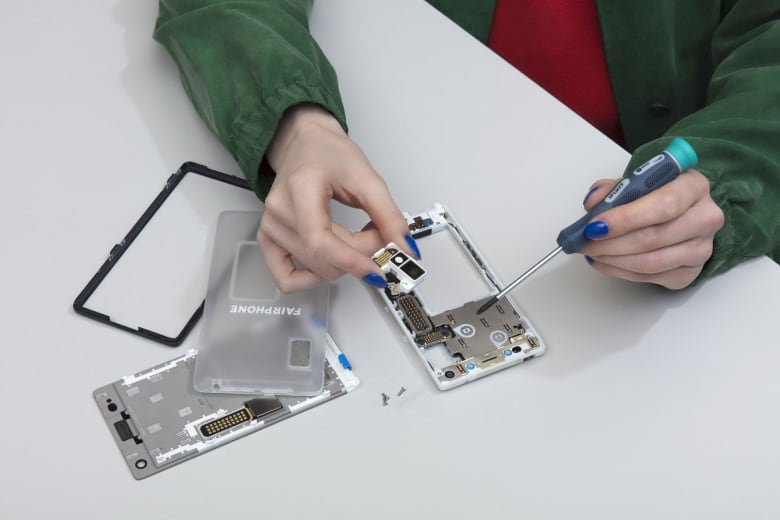
Hello, Earthlings! This is our weekly newsletter on all things environmental, where we highlight trends and solutions that are moving us to a more sustainable world. (Sign up here to get it in your inbox every Thursday.)
This week:
- Is it possible to make a sustainable smartphone?
- Oil spills are destructive but they’re happening less
- Geothermal energy may not be the answer to Alberta’s orphan well problem
Is it possible to make a sustainable smartphone?

Every year on Black Friday and Cyber Monday, retailers whip out deals tempting us to buy shiny new devices, including smartphones.
Maybe you were already thinking about a new purchase, since your apps have slowed down and your battery life has shrunk. Or maybe you dropped your phone and have discovered that finding a place to fix it isn’t easy, or that the repair will cost more than buying a new one. (We’ve previously discussed why this is.)
These are some of the reasons many people suspect or accuse technology companies of “planned obsolescence,” the practice of designing and making products that quickly become obsolete, requiring you to replace them. Whether or not it’s by design, it’s clear that replacing them frequently has an environmental downside.
A 2018 study by researchers at McMaster University in Hamilton found that 85 per cent of the emissions impact from a smartphone comes from production rather than use. Emissions aren’t the only problem — smartphones contain metals and minerals that are mined at high environmental and human cost.
But is it possible to design a smartphone that lasts?
Fairphone, a social enterprise in the Netherlands, has been working since 2013 on a sustainable phone. Its modular Android model, which is currently only available in Europe, is designed to be easy to repair. Fairphone sells spare parts and the phone comes with a little screwdriver.
“You can apply the spare parts and replace them yourself,” said Ioiana Pires Luncheon, the company’s PR and communications manager. “We’re encouraging people to keep their phones as long as possible.”
The company launched a camera module in 2017 that allowed users to upgrade their old phones without buying a new one by installing the new camera themselves. It has even taken on the challenge of making its own modifications to new Android versions so they’ll run on older processing chips that aren’t supported by the manufacturer, allowing for software upgrades that would otherwise be impossible.
Luncheon admits the process has not been easy. “Making phones that are all about longevity is a challenge in an industry where products really aren’t made to last very long.”
The company was forced to stop supporting its first phone, the Fairphone 1 (released in 2013), after just 3.5 years because it had licensed a design from a Chinese manufacturer that had stopped making phones and it could no longer get parts. With subsequent versions of the phone, Fairphone realized it needed more control over the design, partly to have more flexibility in sourcing spare parts, the company said in its 2017 annual report.
While there is a lot of talk about planned obsolescence, Luncheon doesn’t think that the big manufacturers are quite so strategic about it.
“It’s really just how the free market operates,” she said. “And it’s not one person. It’s a complex system.” She said that in order to make products last longer, you have to have co-ordination all along the supply chain, including manufacturers of hardware from chips to screens, as well as developers of software such as operating systems. “It’s crucial to have them all on board to make a product last longer.”
She thinks legislation, such as laws forcing standardization of accessories, and consumer awareness could both help with that.
“There is a market there [for longer-lasting devices] and we really want to expand it and get more people on board,” she said. In the meantime, she encourages consumers to keep their phones, no matter what brand or model, as long as possible.
“We always say that the most sustainable phone is the one that you already have.”
— Emily Chung
Reader feedback
Last week, we published a piece that examined how countries can get to their stated target of net-zero carbon emissions by 2050.
Amalie Callahan wrote, “Anything later than 2030 is too late. The climate crisis is already starting.”
Tim Porter wrote, “You can’t unless you figure out how to scare up a worldwide quorum.”
Old issues of What on Earth? are right here.
There’s also a radio show! There is potential in Canada to harness heat from deep below the ground for electricity. So why are there only a handful of geothermal projects breaking ground? What on Earth takes a look at the promise of renewable geothermal power and the barriers to getting there. Listen on CBC Radio One on Sunday at 12:30 p.m., 1 p.m. in Newfoundland, or any time on podcast or CBC Listen.
The Big Picture: Oil spills
Global reliance on oil and gas for the better part of a century has had an adverse impact on the atmosphere — it has also led to some nasty spills that have done significant damage to ecosystems on land and in water. While events like the Exxon Valdez spill (1989) and the Deepwater Horizon disaster (2010) are seared into our popular consciousness, there are many more like them. (Here’s a look at some of the biggest on record.) While any spill can do long-lasting damage to wildlife and people’s livelihoods, the good news is that the number of big spills has been on the wane. According to the International Tanker Owners Pollution Federation, since the ’80s, the number of large spills (i.e. more than 700 tonnes) has dropped from an average of nine a year to two. This is partly due to the fact that ships are more robustly built now. After the Exxon Valdez spill, for instance, U.S. Congress passed legislation requiring oil tankers to have double hulls. Even so, spills still happen — to destructive effect. Earlier this year, a Japanese-owned tanker hit a coral reef and spilled an estimated 1,000 tonnes off the coast of Mauritius, eventually covering an area of 27 square kilometres. The incident has been devastating to this Pacific island nation, which is renowned for its coral reefs.

Hot and bothered: Provocative ideas from around the web
-
Turns out a lot of Europeans and Americans are still confused about climate science. A recent survey by the Open Society European Policy Institute asked people in nine countries (Germany, France, Italy, Spain, Sweden, Poland, the Czech Republic, the U.K. and the U.S.) about climate change and found at least 35 per cent of respondents think scientists are divided on whether people are causing global warming. (In the U.S., the Czech Republic and Poland, this group constituted a majority.) In fact, 97 per cent of climate scientists agree global warming over the past century is a human-made phenomenon.
-
A new United Nations report is projecting severe coral bleaching this century for all of the world’s coral reefs. Bleaching events caused by climate change compromise the reefs, which account for 25 per cent of the world’s marine species and act as a buffer against waves and storms. Based on future modelling, researchers say annual severe bleaching events — when water temperatures exceed the bleaching threshold of 1 C for eight weeks in a three-month-period — could happen as early as 2034.
- A “sustainable” mall is opening in Turin, Italy, this holiday season. Not only does the Green Pea Retail Park sell eco-friendly products and services, but the structure itself was built with the environment in mind. Partially backed by the Farinetti family of Eataly fame, the megaspace is made from upcycled wood, steel and iron materials and is powered by a combination of geothermal energy, mini wind-turbines and solar panels.
- Canada’s fossil fuel consumption might have peaked in 2019. A new report from the Canada Energy Regulator predicts that we could see a 35 per cent reduction in fossil fuel use by 2050 if the country follows the guidelines of the current climate policy.
Geothermal energy may not be the answer to Alberta’s orphan well problem

Alberta recently tabled legislation to put a regulatory framework in place for geothermal energy development, but some experts are skeptical of the plan to repurpose inactive wells.
The government of Alberta estimates there are 2,983 orphan wells in the province.
Geothermal energy extracts heat from the earth underground to make electricity. Like oil and gas development, it requires deep wells. Unlike fossil fuels, geothermal is renewable and a low-carbon energy source.
Steve Grasby, the lead author of a 2012 report on geothermal energy potential in Canada, said oil and gas wells “provide an enormous amount of data and information” on the qualities of sedimentary rock and temperatures that can help determine the optimal geothermal sites in Alberta. But he cautioned that “it’s not too easy to use these petroleum wells for geothermal.”
“Oil well diameters are typically much narrower than standard geothermal wells. So they’re just not wide enough for geothermal production,” said Grasby, a research scientist for the Geological Survey of Canada. “One of the main reasons is that you need a much higher production rate of hot water to make a geothermal plant work than you do for oil or gas.”
In a statement to CBC Radio’s program What On Earth, the Alberta Ministry of Energy cited the “significant potential” of repurposing inactive oil and gas wells, not only as a way to find a new use for old infrastructure but as an opportunity for those in the oil and gas sector to move into new jobs.
“We need to have that conversation: oil and gas and energy like geothermal,” Alberta Energy Minister Sonya Savage said at an October press conference about the province’s energy future. “We see this as a standalone opportunity to bring in a new sector, to drive investment, to do things in Alberta better than anywhere else in the world and to create jobs with that.”
The province says the legislation it tabled on Oct. 20, the Geothermal Resource Development Act, will provide a regulatory framework for how the resource would be managed.
However, Sara Hastings-Simon, a research fellow at the University of Calgary’s School of Public Policy, said even if some oil and gas wells can be repurposed for geothermal, “it’s not an answer to the orphan well problem.”
She said there is potential for “bad actors” to avoid paying for well cleanup by handing over the sites for geothermal development.
“That’s something that we really need to guard against in creating the regulatory framework that allows for well redevelopment: making sure that it’s really being done in good faith for the purpose of redeveloping those wells and not being done simply to offload the liability,” Hastings-Simon said.
In a response, a spokesperson for the Alberta Ministry of Energy wrote “the liability management and reclamation principles and obligations related to upstream oil and gas development will also apply to geothermal resource development.”
— Molly Segal
Stay in touch!
Are there issues you’d like us to cover? Questions you want answered? Do you just want to share a kind word? We’d love to hear from you. Email us at whatonearth@cbc.ca.
Sign up here to get What on Earth? in your inbox every Thursday.
Editor: Andre Mayer | Logo design: Sködt McNalty












